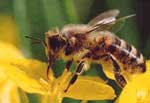 Scientists have pondered whether cell phones are the cause of Colony Collapse Disorder, which has wiped out about a quarter of the North American honeybee population and poses a threat to a quarter of our food supply. They’ve also wondered if the cause could be a virus. Or pesticides. Or mites. Or all of the above.
Scientists have pondered whether cell phones are the cause of Colony Collapse Disorder, which has wiped out about a quarter of the North American honeybee population and poses a threat to a quarter of our food supply. They’ve also wondered if the cause could be a virus. Or pesticides. Or mites. Or all of the above.
Now they’re sending in the Army to figure out what’s causing all the bees to croak. And the Army brought with them … blenders and cheesecloth.
This past spring, a nationwide effort by top DNA scientists determined that CCD is probably caused by a number of factors, including multiple bee-killing viruses. But identifying specific viruses with DNA sequencing is a slow, painstaking process.
That’s where Charles Wick (then the leader of the chemical and biological detection team at the Army’s Aberdeen Proving Grounds in Maryland) came in, volunteering a microwave-size invention to help the cause. Originally used to screen drinking water for pathogens, Wick’s 50-pound Integrated Virus Detection System (IVDS) hits a sample with an electric charge, then counts and sizes the particles making up the sample to identify viruses. By measuring to the nanometer, the IVDS can pin down a disease in 10 minutes.
As a trial run, CCD surveyors sent Wick samples from suffering beehives, which he liquefied in a blender, filtered using a cheesecloth, and ran through the IVDS. “They’d been working on this for six or seven months,” Wick says, “so we brought in a new technology and immediately detected the pathogens they were looking for.”
They’ve got more on it in this week’s podcast, too. More on the disappearing bees here, here, here.

